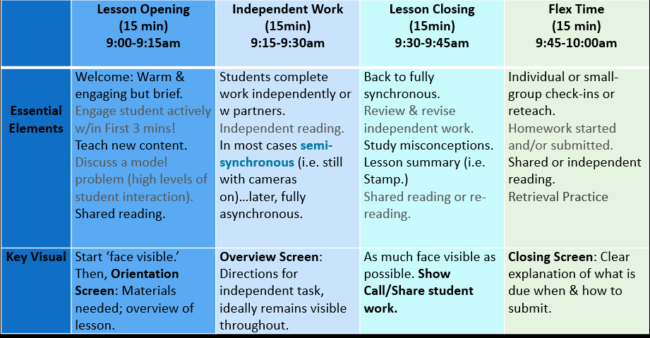07.28.20Darryl Williams’ Framework for Online Lessons
My colleague Darryl Williams leads our partnership work, where we work directly with schools to help them achieve their vision of high-quality equitable instruction in every classroom.
Because he spends so much time working directly with schools as they implement, he’s often the first to propose solutions to emerging challenges, and with COVID-mandated online learning on everyone’s mind, his recent work with a group of our schools is no exception.
Darryl put together a draft framework for what the structure of online lessons could look like across a school. He was building off one of our observations that the biggest challenge of both synchronous and asynchronous instruction is the same: fatigue, tuning out, exhaustion. We know students need face-to-face interactions. But even for adults, hours of Zoom time can be brutal. And asynchronous learning can also be exhausting and isolating. Thus the framework: a fairly brilliant bit of distillation on his part of how to balance the two types of instruction to make online learning both productive and sustainable.
First here’s an overview of what he proposed:


I should note that the idea is that this model is not a mandate…. it would be adapted differently by each school and probably routinely adapted by teachers. But it sets a general structure that’s productive and sustainable and brings some necessary predictability and consistency to what teaching could look like.
In the Lesson Opening, students and teacher are present synchronously. We want a lot of interaction so students feel connected and included and accountable. They should see a smiling face and be asked to do something active–respond to a question in the zoom chat, say–within the first three minutes. And there should be an ‘orientation screen’ near to the beginning so students know what’s coming, and what materials they need to participate. And, as I discussed here, they should be able to see that things are planned and time is important. You might imagine a fusion of these two openings… The way Knikki gets started right away and involves everybody. How both she and Sean have a great Opening Screen with materials needed and activities described… And maybe you could mix in some of Sean’s humor and connected-ness (even though his video is asynchronous):
After ten or fifteen minutes of all of us together, connected and accountable, then maybe it’s time for some independent work. We love the idea of it being ‘semi-asynchronous’… that is, with cameras still on so you can support and check in with kids as Eric does, brilliantly, here. (Notice how seen and supported his kids feel even though they’re reading independently. And notice that the directions are up on his screen the whole time in case they forget.) Over time this could be fully asynchronous.
After a bit of independent work maybe it’s time to come back to a synchronous setting to check for understanding, process the independent work, and make sure students were productive on their own. That might look at bit like this clip of Ben Esser’s lesson, which again is highly interactive… there’s a great writing prompt that everyone completes. There are loving Cold Calls. There are breakout rooms (and Ben drops in to one to see how it’s going) etc.:
Then maybe the lesson shifts again to what we call Flex Time… students get some or all of their homework done. There’s time for you to check in with individuals or small groups who need more support. Darryl notes it’s a great time to offer targeted support for students who require accommodations or special education services… and the fact that the time is relatively predictable makes it easier for them to provide support. Kids might get to do a little reading. But you’d also want to be really clear: what work is due when? Submitted how?
When Darryl shared this I just thought it was tremendously useful as a tool to manage and sustain attention and focus, to balance formats in a relatively predictable way to get the most out of online lessons. Hope it’s helpful to you as well.
